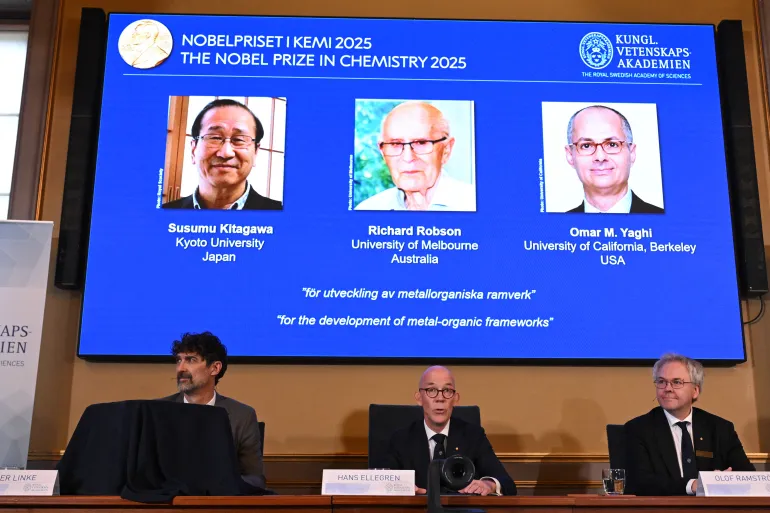The 2025 Nobel Prize in Chemistry Award recognises how porous crystalline materials—metal‑organic frameworks—are reshaping environmental science, clean energy, and industrial chemistry.
Historic Win for Molecular Innovation
The 2025 Nobel Prize in Chemistry Award has been jointly awarded to Susumu Kitagawa (Kyoto University, Japan), Richard Robson (University of Melbourne, Australia), and Omar M. Yaghi (University of California, Berkeley, USA) for their pioneering development of metal‑organic frameworks (MOFs). The Nobel Committee hailed their work as “redefining molecular architecture for the benefit of humanity.”
What Are Metal‑Organic Frameworks?
MOFs are crystalline scaffolds built by connecting metal ions or clusters to organic ‘linker’ molecules, creating ultraporous 3‑D networks. Their key features include:
- Extraordinary porosity – a sugar‑cube‑sized MOF crystal can contain an inner surface area as large as a football field.
- Tunable chemistry – the metal nodes and linkers can be customized to capture or release specific molecules.
- Structural versatility – frameworks can be designed for flexibility, stability, and targeted function.
Because of these qualities, MOFs act as molecular sponges, enabling revolutionary applications such as:
- Carbon dioxide capture for climate mitigation.
- Water harvesting from arid air to address water scarcity.
- Filtering ‘forever chemicals’ (PFAS) and pollutants from drinking water.
- Storing hydrogen and methane for clean energy solutions.
- Catalysis, drug delivery, and advanced chemical separations.
The Nobel Committee compared their microscopic storage capacity to “Hermione Granger’s enchanted handbag”—small on the outside yet capable of holding vast quantities within.
The Laureates’ Contributions
- Richard Robson established the conceptual foundation for building coordination networks and demonstrated the first robust porous crystalline frameworks.
- Susumu Kitagawa advanced methods to stabilize MOFs under practical conditions and studied how gases diffuse and interact within these materials.
- Omar M. Yaghi developed “reticular chemistry,” a systematic approach to linking molecular building blocks into large, porous, and predictable frameworks—expanding MOFs into thousands of new structures ready for real‑world use.
Together, their innovations transformed MOFs from fragile lab samples into scalable materials with industrial relevance.
2025 Nobel Prize in Chemistry Award: Global Significance
Scientists worldwide see MOFs as a cornerstone for addressing 21st‑century environmental challenges:
- Reducing greenhouse gases in the atmosphere.
- Providing low‑cost water purification technologies for underserved regions.
- Offering lightweight gas‑storage materials for renewable energy transport.
The Nobel announcement signals growing recognition that molecular‑level design can drive global sustainability and clean‑tech revolutions.
2025 Nobel Prize in Chemistry Award: Looking Ahead
The prize is expected to accelerate commercial adoption and large‑scale production of MOFs, spurring collaborations between academia, startups, and industries in energy, environment, and healthcare.
FOR MORE BLOGS – beyondthepunchlines.com

 Add to favorites
Add to favorites








